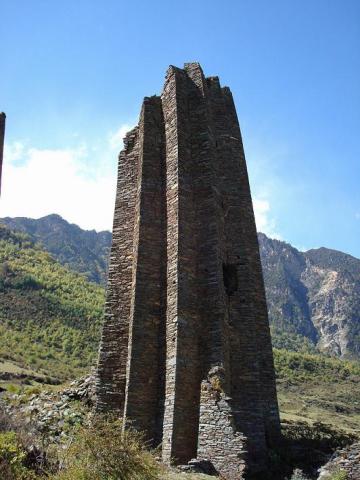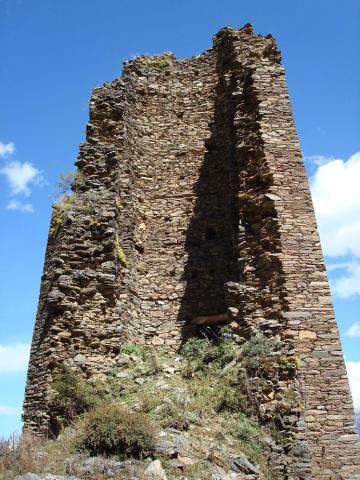

Danba, Contemporary Art and Cultural Heritage Preservation
StartFragment
Danzeng (Tenzin) Jinba and Qiu Zhijie will co-operate to assess one of the most mysterious architectural wonders in the world: the Tibetan Stone Towers in Danba. Qiu Zhijie has been interested in Tibetan culture, history and arts for more than a decade; he is now involved extensively with Tibet (please check this article for more information).
The first trip will take place in June 2099 and will include the two academics and one accompanying architect. This project brings to our attention how important and fundamental co-operation with contemporary artists is to creating not only a better awareness of conservation problems, but also to bringing artists to a deeper level of research of their own or achieving a greater understanding of cultural traditions.
On the Damaged Tibetan Stone Towers in Danba, China
by Danzeng (Tenzin) Jinba
The May 12th 2008 Sichuan earthquake has affected Danba communities tremendously. Apart from human and material losses, one of the most tragic and shocking consequences of the earthquake was the great damage to the invaluable Tibetan stone-towers in Danba County, Ganzi Tibetan Autonomous Prefecture, Sichuan of Southwestern China. According to the county (official) report, 45 such towers are severely damaged, among which 23 are labeled as ‘very dangerous’, namely, they could collapse at any time and are endangering the safety of households living under/around their bases. Actually, in my own investigation, the real situation is much more severe due to the fact that many of the most damaged towers or those which lean greatly are not accounted as being directly affected by the earthquake, and also due to the fact that the officials/cadres in Danba haven’t really done any serious surveying, based on my own observations and villagers’ accounts.
I myself did a three-day (October 9th -11th) preliminary investigation of the 20 towers in the northern mountainside of the Suopo Township, Danba. I found out that almost all of these towers needed some sort of solidification based on the fact that crevices and cracks could be found everywhere. At least 4 towers were in such bad shape that they could collapse at any time. The stone base of these towers and the body itself are splitting, and some of them have crevices of over 30 centimeters wide and 2-3 meters long, and all of them have at least one side and angle destroyed (these are all four-angled towers, thus they all have four sides).
Apart from these 4 it seems many others will potentially collapse in a few years. From October 14th to 15th I started another investigation of the damaged situation in southern mountainside of the Suopo Township. The situation here is not encouraging either. Many of the towers are severely damaged, and the upper parts of some towers are destroyed. Among all these damages, what astonishes me most is the damage of the 13-angled stone-tower. This stone-tower is referred to as the King of the Stone-Towers due to its uniqueness (probably the only one of its type in the world), its exquisite design and magnificent appearance. Its southern sides have totally collapsed and we can easily observe the cracks and crevices on its northern sides–it is the most exquisite tower I have ever seen and its damage is a tremendous loss. If it is not repaired in time the whole structure will collapse soon.
Second Investigation, Spring 2009
Time: June 19th to July 1st, 2009
Location: Suopo Township, Danba County, Sichuan Province, China
This report comprises two parts: the first part is a brief report that is written in English, and the second part is a very comprehensive scientific research/data/analysis in Chinese on the conditions of the stone towers in question.
Objective: to investigate the status quo of the Tibetan Stone Towers (Blockhouses) and the damage from the earthquake and other natural/human factors in Suopo
Research Finding: All 63 stone blockhouses we have investigated are subject to varying degrees of damage. Of the 27 blockhouses that are situated next to villagers’ houses, 14 are seriously damaged, 8 are mildly damaged, and 5 are slightly damaged; of the 36 blockhouses that are not close to any homes, 26 are seriously damaged, 4 are mildly damaged, and 6 are slightly damaged.
Key Members: Tenzin Jinba (organizer, Tibet/Danba specialist and cultural anthropologist), Li Tianjin (architect from Sichuan University, photographer) and Wengzha (local mason)
Variables for the damage: collapse, crevices, twisting, bulging, concavity and material falling off
Comments: On the whole, the damage of these blockhouses is appalling, and if no immediate solidification project is carried out some of the most damaged blockhouses may collapse at any time. The blockhouses collapse will not only the loss of the invaluable cultural heritage, but also means that the life and property of the villagers who live nearby will be threatened. Due to various factors, the local government is unable to do anything practical to save these blockhouses so far. Therefore, the rescue project must be supported by both the domestic and international community. We are looking forward to saving these marvelous human miracles with your generous support.
A detailed scientific report, including technical data and architectural blueprints of all sites investigated, will be available in Chinese.




